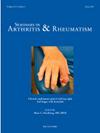复发性巨细胞动脉炎的颅磁共振纵向变化
IF 4.4
2区 医学
Q1 RHEUMATOLOGY
引用次数: 0
摘要
目的研究巨细胞动脉炎(GCA)的疾病活动性监测方法。先前的研究表明,颅血管壁磁共振成像(vw-MRI)的血管增强随着GCA的治疗而减弱,但在复发期间是否增强尚不清楚。本研究探讨了颅脑GCA复发时的vw-MRI变化。方法活动性GCA患者在入组和第1、6、12个月以及疑似复发时获得颅骨vw- mri。神经放射学家对几个结构进行了vw-MRI增强分级。将MRI评分的变化与临床确定的疾病活动性和急性期反应物(APR)进行比较。结果共纳入14例GCA患者:4例颅脑或眼部复发;2例患者复发为多肌痛风湿病(PMR),无颅内症状;8例患者持续缓解。所有4例颅脑或眼部复发的患者至少有一个颅脑结构的磁共振成像增强。2例复发的PMR患者持续增强但未增强,而8例持续缓解的患者中有7例随访时增强减弱或正常。复发时显示增强的颅骨结构包括枕动脉、视神经鞘和上颌动脉。APR水平在大多数复发中保持正常,可能受到使用托珠单抗的影响。结论颅脑GCA复发时,即使APR水平保持正常,vw-MRI也能观察到颅脑结构增强。这些数据证明了vw-MRI在GCA纵向疾病监测方面的潜力。本文章由计算机程序翻译,如有差异,请以英文原文为准。
Longitudinal changes on cranial magnetic resonance imaging in relapsing giant cell arteritis
Objective
There is a need for better tools to monitor disease activity in giant cell arteritis (GCA). Prior studies demonstrated that vascular enhancement on cranial vessel wall magnetic resonance imaging (vw-MRI) decreases with treatment of GCA, but whether enhancement increases during relapse is not well known. This study examined changes on vw-MRI during relapse of cranial GCA.
Methods
Patients with active GCA acquired cranial vw-MRIs at enrollment and months 1, 6, and 12 and if suspected relapse occurred. Neuroradiologists graded vw-MRI enhancement for several structures. Changes in MRI scores were compared with clinically-determined disease activity and acute phase reactants (APR).
Results
Fourteen patients with GCA were included: 4 patients experienced a cranial or ocular relapse; 2 patients experienced a relapse with polymyalgia rheumatica (PMR) without cranial symptoms; and 8 patients were in sustained remission. All 4 patients who experienced cranial or ocular relapse had increased vw-MRI enhancement in at least one cranial structure. Two patients experiencing relapse of PMR had persistent but not increased enhancement, while 7 of 8 patients in sustained remission had decreased or normal enhancement on follow-up. Cranial structures that showed increased enhancement at relapse included the occipital artery, optic nerve sheath, and maxillary artery. APR levels remained normal in most relapses, likely impacted by use of tocilizumab.
Conclusion
During relapse of cranial GCA, increased contrast enhancement of cranial structures is observed on vw-MRI even when APR levels remained normal. These data offer proof-of-concept that vw-MRI has potential for longitudinal disease monitoring of GCA.
求助全文
通过发布文献求助,成功后即可免费获取论文全文。
去求助
来源期刊
CiteScore
9.20
自引率
4.00%
发文量
176
审稿时长
46 days
期刊介绍:
Seminars in Arthritis and Rheumatism provides access to the highest-quality clinical, therapeutic and translational research about arthritis, rheumatology and musculoskeletal disorders that affect the joints and connective tissue. Each bimonthly issue includes articles giving you the latest diagnostic criteria, consensus statements, systematic reviews and meta-analyses as well as clinical and translational research studies. Read this journal for the latest groundbreaking research and to gain insights from scientists and clinicians on the management and treatment of musculoskeletal and autoimmune rheumatologic diseases. The journal is of interest to rheumatologists, orthopedic surgeons, internal medicine physicians, immunologists and specialists in bone and mineral metabolism.

 求助内容:
求助内容: 应助结果提醒方式:
应助结果提醒方式:


